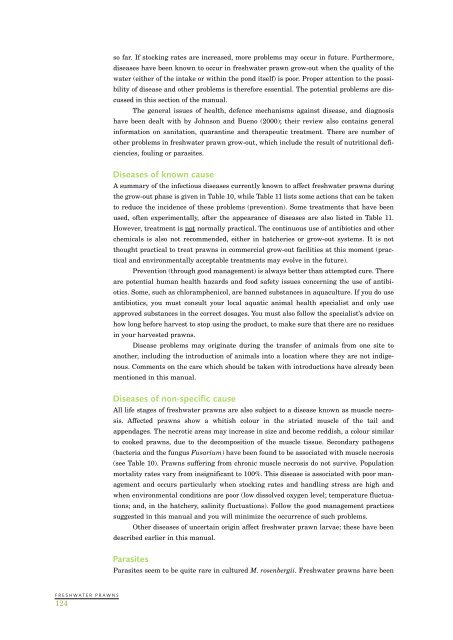You also want an ePaper? Increase the reach of your titles
YUMPU automatically turns print PDFs into web optimized ePapers that Google loves.
so far. If stocking rates are increased, more problems may occur in future. Furthermore,diseases have been known to occur in <strong>freshwater</strong> prawn grow-out when the quality of thewater (either of the intake or within the pond itself) is poor. Proper attention to the possibilityof disease and other problems is therefore essential. The potential problems are discussedin this section of the manual.The general issues of health, defence mechanisms against disease, and diagnosishave been dealt with by Johnson and Bueno (2000); their review also contains generalinformation on sanitation, quarantine and therapeutic treatment. There are number ofother problems in <strong>freshwater</strong> prawn grow-out, which include the result of nutritional deficiencies,fouling or parasites.Diseases of known causeA summary of the infectious diseases currently known to affect <strong>freshwater</strong> <strong>prawns</strong> duringthe grow-out phase is given in Table 10, while Table 11 lists some actions that can be takento reduce the incidence of these problems (prevention). Some treatments that have beenused, often experimentally, after the appearance of diseases are also listed in Table 11.However, treatment is not normally practical. The continuous use of antibiotics and otherchemicals is also not recommended, either in hatcheries or grow-out systems. It is notthought practical to treat <strong>prawns</strong> in commercial grow-out facilities at this moment (practicaland environmentally acceptable treatments may evolve in the future).Prevention (through good management) is always better than attempted cure. Thereare potential human health hazards and food safety issues concerning the use of antibiotics.Some, such as chloramphenicol, are banned substances in aquaculture. If you do useantibiotics, you must consult your local aquatic animal health specialist and only useapproved substances in the correct dosages. You must also follow the specialist’s advice onhow long before harvest to stop using the product, to make sure that there are no residuesin your harvested <strong>prawns</strong>.Disease problems may originate during the transfer of animals from one site toanother, including the introduction of animals into a location where they are not indigenous.Comments on the care which should be taken with introductions have already beenmentioned in this manual.Diseases of non-specific causeAll life stages of <strong>freshwater</strong> <strong>prawns</strong> are also subject to a disease known as muscle necrosis.Affected <strong>prawns</strong> show a whitish colour in the striated muscle of the tail andappendages. The necrotic areas may increase in size and become reddish, a colour similarto cooked <strong>prawns</strong>, due to the decomposition of the muscle tissue. Secondary pathogens(bacteria and the fungus Fusarium) have been found to be associated with muscle necrosis(see Table 10). Prawns suffering from chronic muscle necrosis do not survive. Populationmortality rates vary from insignificant to 100%. This disease is associated with poor managementand occurs particularly when stocking rates and handling stress are high andwhen environmental conditions are poor (low dissolved oxygen level; temperature fluctuations;and, in the hatchery, salinity fluctuations). Follow the good management practicessuggested in this manual and you will minimize the occurrence of such problems.Other diseases of uncertain origin affect <strong>freshwater</strong> prawn larvae; these have beendescribed earlier in this manual.ParasitesParasites seem to be quite rare in cultured M. rosenbergii. Freshwater <strong>prawns</strong> have beenFRESHWATER PRAWNS124
















